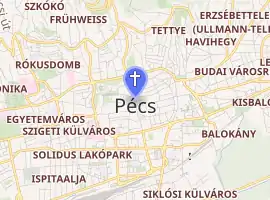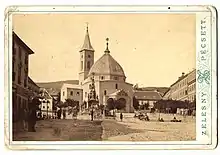Mosque of Pasha Qasim
The Downtown Candlemas Church of the Blessed Virgin Mary (Hungarian: Belvárosi Gyertyaszentelő Boldogasszony-templom), formerly known as the Mosque of Pasha Qasim (Hungarian: Gázi Kászim pasa dzsámija, Turkish: Gazi Kasım Paşa Camii) is a Roman Catholic church in Pécs, Hungary, which was a mosque in the 16–17th century due to the Ottoman conquest. It is one of the symbols of the city, located in the downtown, on the main square (Széchenyi square). The current building, a hundred steps in length and in width, was built by Pasha Qasim the Victorious between 1543 and 1546. The mosque was converted to a church in 1702,[1] after Habsburg-Hungarian troops reconquered the city. The minaret was destroyed by the Jesuits in 1766. One of the largest Ottoman constructions remaining in Hungary, the building still retains many Turkish architectural characteristics.
| Downtown Candlemas Church of the Blessed Virgin Mary | |
|---|---|
| Belvárosi Gyertyaszentelő Boldogasszony-templom | |
_3.jpg.webp) The church with the Holy Trinity statue (1714) and the John Hunyadi statue (1956) | |

| |
| Location | Pécs |
| Country | Hungary |
| Denomination | Roman Catholicism |
| Previous denomination | Islam |
| History | |
| Former name(s) | Mosque of Pasha Qasim |
| Architecture | |
| Years built | 16th century |
| Specifications | |
| Length | 29m |
| Width | 16m |
| Height | 23m |

History

Standing at the highest point of Pécs's Széchenyi square, the mosque of pasha Qasim is the greatest example of Turkish architecture in Hungary. It probably was built in the second half of the 16th century, some years after the Ottomans occupied Pécs in 1543. In the 1660s, the famous Turkish traveller Evliya Çelebi wrote of the overwhelming majesty of its view.
A number of changes were made to the building between the 18th and the 20th centuries: its minaret was taken down after having been enlarged; only the bulk (the octagon drum, covered by a dome, patterned after traditional Orthodox cathedrals) remained of the original structure. Arc windows are set in two rows on the façades of the southeastern, southwestern, and northeastern sides of the building; 3–3 and 4-4 pieces. Inside, some Ottoman decoration and inscriptions from the Qur'an are clearly visible in the remaining plaster parts. The Turkish pulpit and the women's balcony have been destroyed, and the mihrab is not the original. The two Turkish bathing basins before the sacristies (today, holy water) were taken from the former bath of the pasha next to the church. The building now functions as a Roman Catholic church.
See also
References
- Rados Jenő: Magyar építészettörténet (p. 161–168) – 1961. Bp. Műszaki K. – ETO 72 (439) 091 (in Hungarian)
- Szerk. Fülep L.: A magyarországi művészet története (p. 371–372) – Bp.1961. Képzőmúv. Alap K. – Kossuth Ny. 61.3465. (in Hungarian)
- Goldziher Ignác: Az iszlám kultúrája – Gondolat K. Bp. 1981. – ISBN 963-280-607-7 (in Hungarian)
- H. Stierlin: Iszlám művészet és építészet – Bp. Alexandra K. – ISBN 963-368-127-8 (in Hungarian)
- H. Stierlin. Türkei – Architektur von Seldschuken bis Osmanen – Taschen Weltarchitektur – ISBN 3-8228-7857-X (German)
- Pécs Lexikon, Ferenc Romváry, Pécs, 2010, pp. 98, ISBN 978-963-06-7919-0
External links
![]() Media related to Mosque of pasha Qasim at Wikimedia Commons
Media related to Mosque of pasha Qasim at Wikimedia Commons